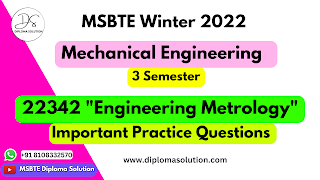Important Practice Question Available for Exam. This Questions are based on Repeated Topics and Frequently Ones with the Help of this you can Score Good Marks in Exam and you will Pass in Exam.
Get Updates on: WhatsApp YouTube Instagram
1. Attempt any five of the
following : 10
a) Define ‘metrology’. **
b) State any four advantages of
optical comparator.
c)
State the term selective assembly.
d) Draw neat sketch of metric
screw thread profile.
e) List down instrument used in angular
measurement. *
f) Define sampling length.
g) Define straightness.
h) List different measuring
standards.**
i) State the advantages of interchangeability.
(atleast two)
j) Define – Run out w.r.t. gear. **
k) State the use of “combination set”.
l) List the causes of surface roughness. **
m) Define – RMS value.
2. Attempt any three of the
following : 12
a) Differentiate between
systematic errors and random errors.
b) Define wavelength standard.
State advantages and disadvantages. *
c) Explain with neat sketch hole
& Shaft basis system. ****
d) Explain the principle of
measurement of tooth thickness by gear tooth vernier caliper.*
e) Differentiate between
mechanical and pneumatic comparator. (atleast four points) ***
f) Explain working principle of
‘Tool Maker’s’ microscope.
g) Differentiate between accuracy
and precision.**
3. Attempt any three of the
following : 12
a) Distinguish between ‘Alignment
Test’ and ‘Performance Test’ of machine tool.
b) Sketch a micrometer and explain
its working.
c) Draw labelled sketch of sigma
comparator and explain its working. *
d) Differentiate between
‘Tolerance’ and ‘Allowance’.
e) Explain
(i)
Environmental error
(ii)
Calibration error
(iii)
Explain parallax error
f) Draw the diagram indicates a reading of
4.32 mm on vernier scale
4. Attempt any three of the
following : 12
a) Prepare stack of slip gauges
for height 58.975 mm using set M112. *

b) Explain the working principle
of floating carriage dial micrometer enlist its application.***
c) Explain terminology of screw
thread.
d) Explain the principle of stylus
probe type direct instrument measurement of surface finish.
e) Draw the following alignment
test of Lathe machine. **
1)
Levelling of Lathe machine
2)
Parallelism of main spindle to saddle movement.
3)
Parallelism of tail stock
4)
Run out of spindle
Batch-2
(a) Measure a distance of 6.905 mm
with the help of slip gauges using 112 set of slip gauges. Show the arrangement
with neat sketch.
(b) A shaft of 25 0.004 mm is to be checked
by meance of GO and NOGO gauge. Design the dimensions of a gauge required.
(c) Write the examples of use of following
types of fits :
(i)
Push fit
(ii)
Press fit
(iii)
Running fit
(iv) Wringing fit
(d) An angle of 49 29 18 is to be
developed by using standard angle gauge set of 13 pieces. Calculate the gauges
required and sketch the arrangement. **
(e) Explain procedure to determine whether the
given surface is concave or convex by using optical flat.
(f) Draw slip gauge accessories (any two) and
describe the use of it.
(g) In a limit system, the following limits
are specified to give a clearance fit between the shaft and hole.
Shaft
: 30– 0.005 – 0.018 mm
Hole
: 30+ 0.020 – 0.000 mm
Determine (i) Basic size (ii) Shaft and hole
tolerance (iii) Minimum and maximum clearance.
(h) Draw
the alignment test of squareness of spindle of radial drilling machine.
5. Attempt any two of the
following : 12
a) Describe with neat sketch the working
of ‘Parkinson gear tester’ . **
b) Define accuracy and list any
four factor affecting accuracy of instrument. *
c) Explain why size bar is not
used for angle greater than 45° if accuracy in angle measurement is required.*
d) In the measurement of surface
roughness, height of 10 successive peaks and valleys were measured from a datum
as
Peaks – 45, 42, 40, 30, 35 microns.
Valleys
– 30, 25, 25, 24, 18 microns.
Determine the Ra value of the surface. If
these values are obtained over length of 20 mm, find CLA & RMS values.
e) Draw symbol for designating
surface finish on drawing.
6. Attempt any two of the
following : 12
a) Describe ‘Taylor’s principle’
for design of limit gauges. **
b) An angle of 57°6′9″ is to be
developed using standard angle gauges set of [1°, 3°, 9°, 27°, 41°], [1′, 3′,
9′, 27′], [3″, 6″, 18″, 30″] and show arrangement using sketch.
c) Describe the flatness testing
done by using optical flats.*
d) Sketch and interpret the
meaning of various interference fringes patterns observed using optical flat. *
e) The angle of taper plug gauge
is to be checked using sine centre and slip gauges. Sketch the set-up and
describe the procedure.
NOTE: This is Not Official MSBTE Website: We Provide Important Practice Questions for Students to Score Good Marks in Exam and this Questions is based on Important Topics of Syllabus and Repeated Ones. So, with the help of this we help student to Not get KT / or / They will Not get Fail in Exam.

